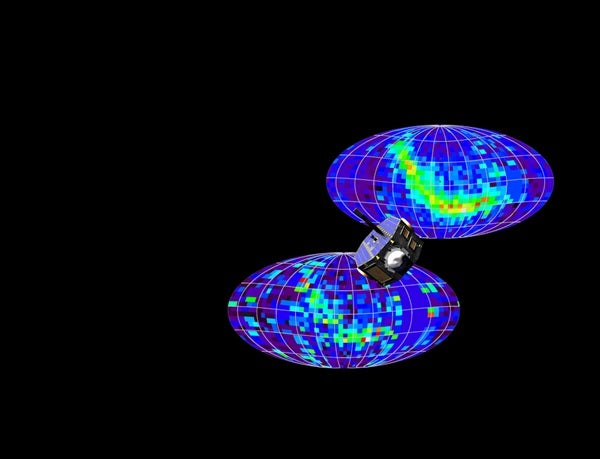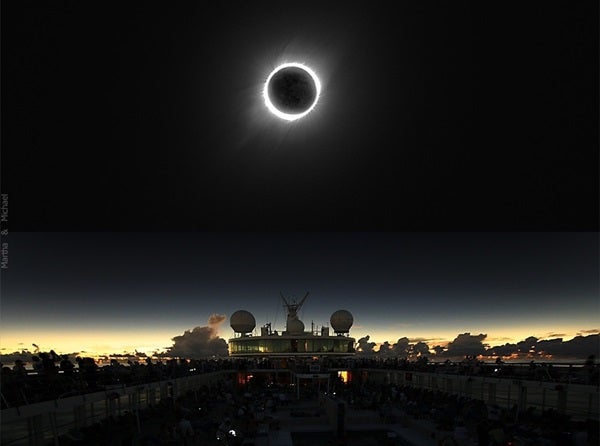One of the most unexpected discoveries of 2009 came from a spacecraft. NASA’s Interstellar Boundary Explorer — IBEX — created the first all-sky map of energetic neutral atoms beyond the solar system’s fringe, only to find it dominated by a strange, enormous, arc-like feature soon dubbed “the ribbon.”
The sharp curve in the ribbon is not actually real, but is instead an artifact of producing a flat map of the hemispheric sky. Orbiting satellites make beelines around Earth, but when plotted on the big screen at Mission Control, their tracks form up-and-down sine waves. Similarly, the ribbon discovered by IBEX is actually just a slightly curved slash across the heavens, exaggerated by the way it’s plotted.

Bringing the universe to your door. We’re excited to announce Astronomy magazine’s new Space and Beyond subscription box – a quarterly adventure, curated with an astronomy-themed collection in every box. Learn More >>.
Its location is on the edge of our solar system, near the heliopause, where our Sun’s influence gives way to incoming interstellar particles. The mapped items are called ENAs, or energetic neutral atoms, because they move quickly and thus have high kinetic energy.
Soon after the discovery, six hypotheses were proposed. All involved various intimate relationships to our star, while a newer theory offered a more dramatic explanation that ignores the Sun totally.
The idea of a continuous stream of particles flowing outward from our star was first suggested by British astronomer Richard Carrington in 1859. About a century later, physicist Eugene Parker said that comet tails always point away from the Sun simply because a “solar wind,” as he called it, pushes on them. Parker was widely ridiculed, and yet, the very next year, the Soviet Luna 1 spacecraft detected such particles whizzing a million miles an hour. Nowadays, a fleet of spacecraft, including the Solar Dynamics Observatory launched in 2010, routinely monitors the solar wind.
It’s been assumed for decades that this wind eventually meets its match far beyond Pluto, where it encounters incoming atomic particles from the stars. The place where the two collide is called the heliopause. The Voyager spacecraft detected signs of its existence, and Voyager 1 should encounter the heliopause in 2015 when it is 133 astronomical units (AU, the Earth-Sun distance) away.
It is this still-mysterious heliopause that the IBEX spacecraft was designed to study. But no one was prepared for the huge ribbon of fast-moving ENAs it detected — three to six times denser than anyone expected, and coming toward us!
Many space physicists believe the ribbon results from the solar wind encountering our galaxy’s magnetic field, which then forces the charged particles to change direction, essentially reflecting them back. Along the way, the protons pick up stray electrons to create neutral high-speed atoms that continue inward. In other words, the ribbon is an echo — an echo of our Sun. If true, it’s exciting because such large-scale caroming billiards has a certain appeal. Moreover, this would, for the first time, provide information about the galaxy’s local magnetic field.
The newer hypothesis ignores the Sun and claims that as we orbit the center of the Milky Way, our solar system is now traversing a cloud of energetic hydrogen gas about 10 light-years across. This in turn is embedded within a much larger nebula of million-degree gas called the Local Bubble. By this thinking, the IBEX ribbon is created by particles captured and exchanged at the boundaries between the two gaseous blobs. This means the ribbon reveals the edge of the boundary between these nebulous masses.
To see this so clearly and so closely, it would also mean the Sun and Earth are about to penetrate the thicker of the masses — probably within the next century. If true, our world is now poised to enter a million-degree cloud of interstellar gas, the probable remnant of one or more supernova explosions that went off just a few million years ago.
If so, the IBEX ribbon is an accidental alignment where we’re positioned just right to sight along the boundary’s edge. When you blow a bubble, you barely see its center but easily observe its round outline. Similarly, we’re now within a mere thousand AU of the boundary as we prepare to penetrate the thin hot gas, possibly in the lifetimes of our children.
It won’t be Armageddon. Earth and the Sun have moved in and out of such hot nebulae in the past. Once we’re inside again, however, the heliosphere may get pushed inward and shrink a bit. Cosmic radiation levels may rise slightly. Future colonists on Mars or the Moon may need even more radiation protection than now envisioned.
If this view is correct, the IBEX ribbon is our first “red alert” of things to come.










